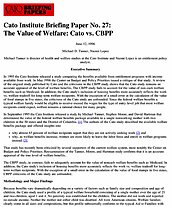In September 1995 the Cato Institute released a study by Michael Tanner, Stephen Moore, and David Hartman that determined the value of the federal welfare benefits package available to a single nonworking mother with two children in the 50 states and the District of Columbia. [1] The authors of the Cato study described the available welfare benefits package and offered insights into
- why almost 65 percent of welfare recipients report that they are not actively seeking work [2] and
- why, as welfare benefits increase, women are more likely to leave the labor force and enroll in welfare programs instead. [3]
That study has recently been criticized by several supporters of the current welfare system, most notably the Center on Budget and Policy Priorities. Reexamination of the Tanner, Moore, and Hartman study confirms that it is an accurate appraisal of the true level of welfare benefits.
The CBPP study, in contrast, fails to adequately account for the value of noncash welfare benefits such as Medicaid. In addition, the Cato study’s inclusion of housing benefits more accurately reflects the work vs. welfare tradeoff for long-term welfare recipients. With the exception of a small error in the calculation of the value of food stamps in five states, CBPP criticisms of the Cato study are unfounded.

